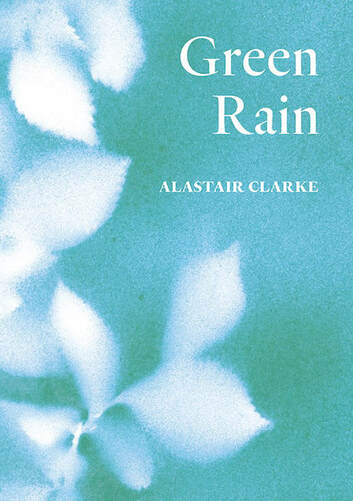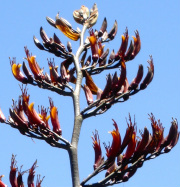
by Alastair Clarke
Green rain falls over a lot of territory, from the Wairarapa to Canberra and America. This collection is divided into five sections: Dance, Churning, Seeing, Hedging, and Crossing. While the various sections don’t seem to have particular relationships to their names, they come together to form a consistent text in the full book.
The title poem (given in full here) is a good introduction to the poet’s style:
... this window, 80cm x 80cm:
seeing now how leaves spiderly –
see there, so many, so many –
reach beyond frame,
beyond the neighbouring gutter
to gather nearer sun –
movements unseen, like conjuring,
the tips of each looped canoe
fast on each stem ...
but to know, distant,
a farmer grasping through days for signs
in a barren sky that might repair his
grey land; that he might see small green canoes
arcing through green rain ... (p 17)
There is a lot of landscape and movement, a wide view of an open idea – but to my mind, the author doesn’t do himself or his work justice. I am left with an impression of someone wandering through lavishly furnished rooms, picking up objects at random and then putting them down again, without taking matters further or connecting them with each other.
This is noticeable not only with topics but in matters of style. The first three lines here have wonderful alliteration, but then we stop. There are a few g-sounds later, but they don’t seem to belong together as well as the sibilants do. There’s quite a lot of alliteration throughout the collection, and it seems as though it could be more of a focus than an (apparent) accident.
Looking at the rest of this stanza, I also can’t understand any pattern for omitting/including the definite article the. Are frame and sun to be taken in a broader? different? sense than the gutter? Clarke uses both these style devices throughout the book, but for what reason isn’t quite clear.
As well as the content of individual poems, the arrangement of poems in a collection makes a major contribution to the meaning of the whole work, and I think again here the author is selling himself short.
For example, there are quite a few references to geology throughout the book. We have, in ‘Tauranga’ (p 26):
This town’s sea-sculpted,
carved still by sea’s incursions
– by its volcanic making
In ‘High Country’ (p 51) we are shown:
These volcanic extrusions
scarring the high plateau, these
(it is mid-winter) under snow.
Passing through is passing through
a geology primer –
And ‘Rotorua’ (p 80) ends with:
Rotorua, sited so confidently
upon its thin clay, above such
geologic, such chemical fury.
Was it arrogance, carelessness
to think that in this land of geyser
and volcano and earthquake humans
would win? – Or ignorance?
So questions
remain – How to walk lightly,
attentively on this land ...
And there are more geology references – enough that they could be put near each other, providing a focused group of poems, rather than leaving the reader with informative, but basically light-weight, casual observations. We could say something similar about the book’s use of ‘seeing’ as a theme: it is spread far too thin and leaves us wondering ‘seeing what?’ or why it matters, since the verb itself appears in most of the poems (every one in the first section).
Perhaps this is a fair summary of the collection as a whole, that we are given an abundance of observation, but very little involvement in, such a wide display of notable landscapes, scenes and experiences.
This is the first book from a new publisher, and it’s a pleasure (reviewer bias!) to see that Ugly Hill Press chose to start out with a poetry collection. The presentation is appropriate to the book, bar some proofreading glitches (both text and bibliographic information). We wish everyone involved well for the future and look forward to seeing what comes next.
Author: Alastair Clarke
Publisher: Ugly Hill Press
ISBN: 978-1-7385836-0-7
RRP: $30
Available: bookshops

 RSS Feed
RSS Feed
